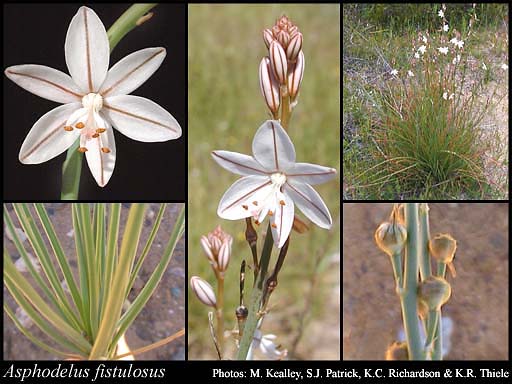- Reference
- Sp.Pl. 1:309-310 (1753)
- Conservation Code
- Not threatened
- Naturalised Status
- Alien to Western Australia
- Name Status
- Current
Annual or biennial, herb, 0.2-0.4 m high. Fl. white, Jun to Oct. Sand, clay, calcareous soils.

Distribution
- IBRA Regions
- Avon Wheatbelt, Carnarvon, Coolgardie, Esperance Plains, Gascoyne, Geraldton Sandplains, Hampton, Mallee, Murchison, Nullarbor, Pilbara, Swan Coastal Plain, Yalgoo.
- IBRA Subregions
- Ashburton, Augustus, Cape Range, Carlisle, Chichester, Eastern Goldfield, Eastern Mallee, Eastern Murchison, Fitzgerald, Geraldton Hills, Hamersley, Hampton, Katanning, Lesueur Sandplain, Merredin, Nullarbor Plain, Perth, Recherche, Roebourne, Southern Cross, Tallering, Western Mallee, Western Murchison, Wooramel.
- IMCRA Regions
- Central West Coast, Leeuwin-Naturaliste.
- Local Government Areas (LGAs)
- Albany, Ashburton, Busselton, Canning, Carnarvon, Claremont, Cockburn, Coolgardie, Dandaragan, Dundas, East Pilbara, Esperance, Exmouth, Fremantle, Gingin, Gosnells, Irwin, Kalamunda, Kalgoorlie-Boulder, Karratha, Kent, Koorda, Leonora, Mandurah, Meekatharra, Melville, Mount Magnet, Nedlands, Northampton, Perth, Ravensthorpe, Rockingham, Shark Bay, Stirling, Upper Gascoyne, Wagin, Wanneroo, Waroona, Yalgoo, Yilgarn.
Management Notes (for the Swan NRM Region)
Alternative Names. Asphodelus, Wild Onion, Hollow-stemmed Asphodel.
General Biology. Growth form. Herb. Life form. Perennial. Reproduction. Seed. Dispersal. Wind, machinery, water, clothing. Toxicity. Reported to cause dermatitis. Seedbank persistence. Several years.
Notes. May be annual, biennial or a short-lived perennial. Principally a weed of alkaline sandy or gravelly well-drained soils in winter rainfall areas. Often found on sandy coastal sites and disturbed areas. Frequent in sites with low nutrient levels and may depend on its mycorrhizal associates for nutrients and growth. Frost and drought–hardy once established. Capable of growing and spreading rapidly. Flowers are monoecious (have both male and female parts) and are insect pollinated. Produces prolific seed. Germination usually occurs within 1-3 months of seed maturity at 15°C. Seeds germinate at any time of year however the main flush occurs during late summer and autumn. Seed is dispersed through wind-blown old infloresences still bearing seed in capsules. Plants growing from seed usually develop flowers at 18 months. After spring, the flowering portion dies away. Leaves remain over summer and new leaves are produced from the base of the plant the following autumn. Declared plant in Victoria.
Additional information. Origin. Northern Africa, Southern Africa, temperate Asia, southeastern Europe, Mediterranean, southwestern Europe. History of use/introduction. Ornamental, seed contaminant. Similar exotic species. Trachyandra divaricata.
Suggested method of management and control. Hand pull small infestations. Apply metsulfuron-methyl at 0.1 g /10 L + 100 ml spray oil when flowering. Read the manufacturers' labels and material safety data sheets before using herbicides. For further information consult the Australian Pesticides and Veterinary Medicines Authority to determine the status of permits for your situation or state.
Management Calendar
| Calendar Type | Jan | Feb | Mar | Apr | May | Jun | Jul | Aug | Sep | Oct | Nov | Dec | Comments |
|---|---|---|---|---|---|---|---|---|---|---|---|---|---|
| Active Growth | Y | Y | Y | Y | Y | Y | |||||||
| Germination | O | O | O | O | U | U | U | U | O | O | O | O | |
| Flowering | Y | Y | Y | Y | |||||||||
| Fruiting | Y | Y | Y | ||||||||||
| Manual Removal | Y | Y | Y | Y | Y | Y | Y | Y | Y | Y | Y | Y | |
| Herbicide Treatment | Y | Y | Y | Y |
Legend: Y = Yes, regularly, O = Occasionally, U = Uncertain, referred by others but not confirmed.
References
- Badano, E.I. & Pugnaire, F.I. (2004) Invasion of Agave species (Agavaceae) in south-east Spain: invader demographic parameters and impacts on native species. Diversity and Distributions, 10: 493-500.
- Bell, D.T. (1993) The effects of light quality on germination of eight species from sandy habitats in Western Australia. Australian Journal of Botany, 41 (3): 321-326.
- Boatwright, J.S. (2012) Asphodelus fistulosus (Asphodelaceae, Asphodeloideae), a new naturalised alien species from the West Coast of South Africa. South African Journal of Botany, 79: 48-50.
- Brown, K. & Brooks, K. (2002) Bushland Weeds: A Practical Guide to their Management. Environmental Weeds Action Network, Greenwood.
- Cavagnaro, T.R., Smith, F.A., Ayling, S.M. & Smith, S.E. (2003) Growth and phosphorous nutrition of a Paris-type arbuscular mycorrhizal symbiosis. New Phytologist, 157: 127-134.
- Department of Agriculture and Food WA (2007) Onion weed (Asphodelus fistulosus). Government of Western Australia URL: http://www.agric.wa.gov.au/PC_93103.html?s=1001 - Accessed February 2010.
- Department of Primary Industries (2009) Invasiveness Assessment - Onion Weed (Asphodelus fistulosus) in Victoria. The State of Victoria URL: http://www.dpi.vic.gov.au/dpi/vro/vrosite.nsf/pages/invasive_onion_weed - Accessed February 2010.
- Hussey, B.M.J., Keighery, G.J., Dodd, J., Lloyd, S.G. & Cousens, R.D. (2007) Western Weeds. A guide to the weeds of Western Australia. 2nd Edition. The Plant Protection Society of Western Australia, Victoria Park.
- Moore, J.H. & Wheeler, J. (2008) Southern weeds and their control. DAFWA Bulletin 4744.
- Parsons, W.T. & Cuthbertson, E.G. (2001) Noxious weeds of Australia. 2nd Edition. CSIRO Publishing, Collingwood.
- Patterson, D.T. (1996) Temperature and photoperiod effects on Onionweed (Asphodelus fistulosus). Weed Technology, 10 (4): 684-688.
- Pitt, J.L., Virtue, J.G. & Feuerherdt, L.J. (2006) Onion weed: Pest or perception. In Managing weeds in a changing climate: Australian weeds conference, 15th, 24-28 Sep 2006, Adelaide SA, eds Preston, C., Watts, J.H. & Crossman, N.D., p454-457. Weed Management Society of South Australia, Adelaide SA.
- Plants For A Future (2008) Asphodelus fistulosus - L. Onionweed. URL: http://www.pfaf.org/database/plants.php?Asphodelus+fistulosus - Accessed Febraury 2010.